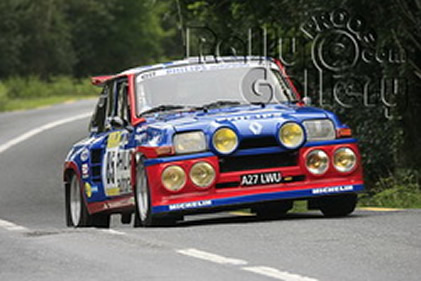Background
The official history of the Renault 5 (R5) Turbo can be traced back to 1976 when a Renault Director called Jean Terramorsi persuaded the company to build a ‘rally special’. Originally the idea was to use the 3ltr V6 engine from the Renault 20, although this was quickly discounted as it took the overall weight above the target 1000kgs. Therefore attention turned to the deminutive normally aspirated 1397cc 4 cylinder engine used in the R5 Alpine, although in this guise it would feature a large turbo-charger.
The R5 Turbo was launched to the public in October 1978, with wholesale production beginning in early 1980. Some of Renault’s board doubted the ability to sell the 400 road cars required to meet Group 4 homologation, although their fears were quickly dispelled as this number was almost pre-sold such was the interest enabling it to make its WRC debut on that year’s Tour de Corse, an event that Jean Ragnotti led for most of before an alternator failure put him out.
The introduction of Group B regulations for the 1983 season saw the R5 switch to the new regulations, which brought its own problems. As even with the 40% turbo factor applied the engine capacity came in under the 2000cc limit and therefore the car had to run with a narrower track and tyres, which made the already tricky handling even more awkward, but successes did come.
Renault pushed ahead with development and in the following years introduced an upgrade called the R5 Turbo 2 culminating in the all new R5 Maxi Turbo. The Maxi Turbo had an increased engine capacity of 1527cc which meant the car finally breached the 2000cc limit. This enabled the car’s wheel track to be widened, which together with the addition of the now obligatory Group B wings and wheel arches, meant the engineers were at last able to cure the nervousness of its narrow track small wheeled pre-runner.
The R5 Maxi Turbo also saw turbo lag finally eliminated, through the introduction of a mechanical anti-lag system, which Renault engineers had borrowed from their turbo charged Formula 1 engine programme.
This Car
Was built in 1984 by John Price Rallying and Renault Sport France for John Price to contest the 1984/85 British Tarmac Championship, and compete it did, taking the overall title in its debut season.
The car was purchased in 1997 by its current owner in dismantled pieces from a friend who had planned to restore it himself, but had lost interest and left it collecting dust in the corner of a garage. With help from a number of friends the complete nut and bolt restoration took 3 years, with careful attention being paid to detail and accuracy which has resulted in the car you see before today being presented in the livery as used by Ragnotti and Thimonier on the 1985 Tour de Corse.
Technical
Engine : four-cylinder, in-line, longitudinally mounted rear engine, single camshaft operating valves by push-rods, two valves per cylinder, 350 bhp, 1,527cc
Induction : Bosch fuel injection, Garrett turbocharger
Body : unitary steel chassis, fibreglass doors, panels, bumpers and arches
Suspension front : wishbones, coil springs, telescopic dampers and anti-roll bar
Suspension rear : wishbones, coil springs, telescopic dampers
Transmission : twin plate clutch, five speed gearbox mounted behind engine driving rear wheels
Weight : 905 kg

